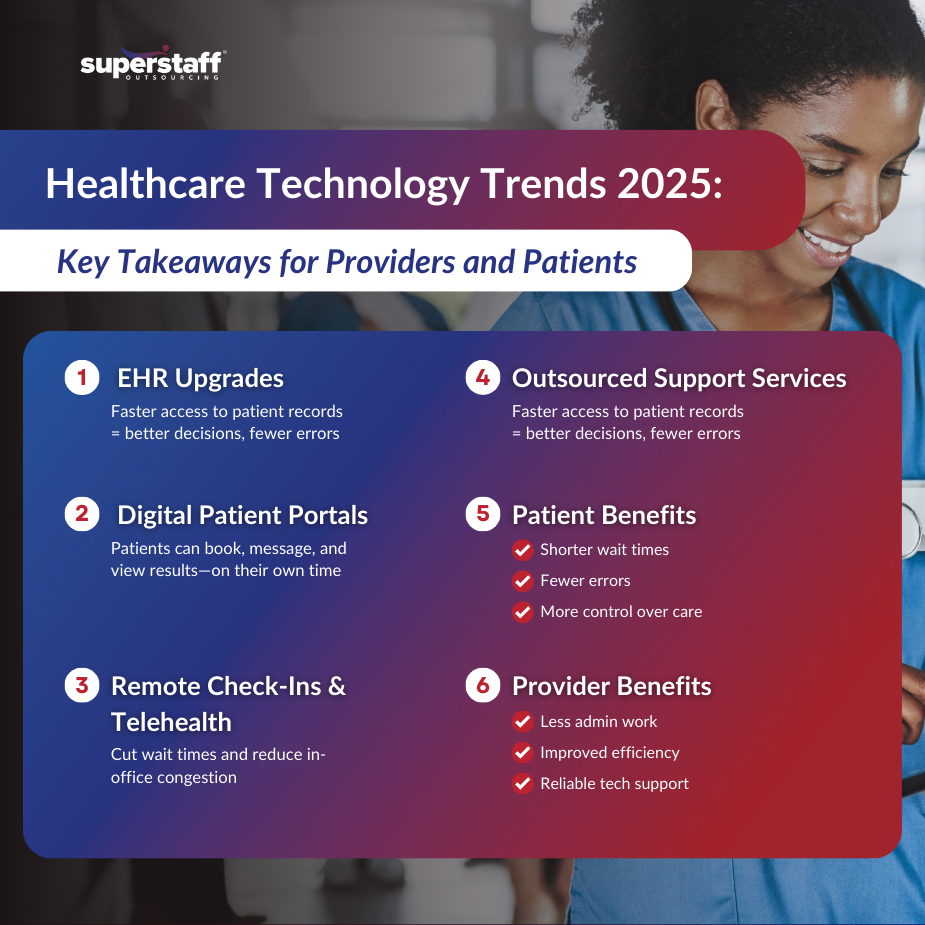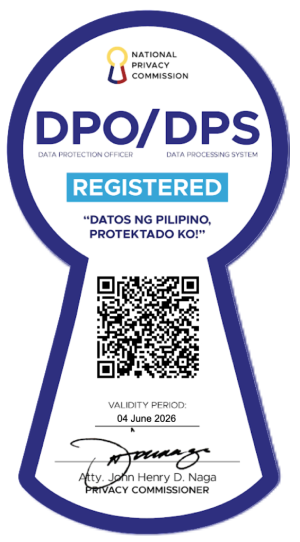
Healthcare organizations are pouring resources into new technology, but what does that actually mean for the people at the heart of it all: patients and providers?
The rise of healthcare technology trends in 2025 is reshaping care is delivered and managed. Patients can now book appointments online, access their records in seconds, and even consult doctors from the comfort of home. Behind the scenes, providers are navigating complex digital systems that promise greater efficiency, but also come with growing demands.
In this blog, we’ll break down the healthcare technology trends 2025 that are driving these changes and explain how outsourcing can help providers keep up with innovation while continuing to deliver high-quality, patient-focused care.
Healthcare Technology Trends 2025 Are Changing Care Delivery
Healthcare technology trends 2025 are transforming the way care is provided and accessed by patients and healthcare workers.

-
Electronic Health Records (EHRs)
One of the most important changes is the shift from paper records to digital systems. EHRs enable providers to easily track and access patient histories. This reduces errors and helps doctors make better decisions faster. With digital records, healthcare providers can spend less time searching for information and more time focusing on patients.
-
Online Patient Portals
Patient portals give patients more control over their healthcare. They can book appointments, view test results, and communicate with their doctors from home. This reduces the need for in-person visits for non-medical tasks, saving time for both patients and healthcare providers.
-
Remote Check-ins and Telehealth
Remote check-ins and virtual doctor visits, also known as telehealth, are becoming increasingly common. These services enable patients to meet with healthcare providers from the comfort of their own homes, thereby reducing the need for in-office visits. This not only makes it easier for patients to access care but also helps providers manage their time more efficiently.
While Health IT improves efficiency, the rapid health IT industry brings added pressure. Training, integration, and ongoing system maintenance often overwhelm in-house teams that are already stretched thin.
Providers Face Growing Pressure to Keep Up with Digital Systems
Adopting new digital systems brings many benefits, but it also creates new demands for healthcare providers.
- Training and Onboarding. Many providers face the challenge of training staff on how to use new technologies. For example, learning how to navigate an EHR system can take time, and this can slow down daily operations. The time and effort spent on training can cause delays in providing care, particularly in smaller practices with fewer resources.
- System Integration and Workflow Disruptions. Implementing new systems can interrupt daily tasks. If the technology doesn’t work properly or staff are not fully trained, it can lead to slower services and mistakes in patient records.
- Lack of IT Support. Many healthcare organizations do not have dedicated IT staff to manage digital systems. Without the right support, it’s hard to keep these systems running smoothly. Smaller practices, in particular, may struggle to find the resources to maintain their IT infrastructure.
As the health IT industry grows, these challenges will only increase, making it even more important for healthcare providers to find reliable support. Healthcare technology trends 2025 highlight the need for long-term solutions that support both care and operations.
Outsourcing Support Helps Providers Manage Health IT Upgrades Without Service Disruption
Outsourcing provides healthcare organizations with the extra help they need to manage new digital systems while keeping patient care strong.
- Remote Medical Assistants – Outsourcing companies can provide remote medical assistants to handle tasks like data entry and updating patient records. This allows healthcare workers to focus on direct patient care. By outsourcing these tasks, healthcare teams can keep operations smooth without overwhelming in-house staff.
- Support for Patient Portals – Outsourced teams can help manage patient portals by setting up accounts, answering questions, and fixing issues. With this support, patients enjoy a better experience, and staff can focus on clinical work.
- Tech Support Specialists – Outsourcing technical support means problems with digital systems get solved quickly. Whether it’s a system error or a software question, support teams can handle it, keeping everything running properly without slowing down care.
Patients Gain Better Access and Smoother Experiences Through Well-Supported Digital Systems
When healthcare providers partner with outsourcing teams to manage healthcare technology trends 2025, patients see real improvements in their care experience. Scheduling becomes quicker and more efficient, reducing wait times for appointments and test results. Digital portals give patients greater control over their healthcare, allowing them to view records, request prescription refills, and communicate with providers—all without needing to pick up the phone.
Accurate, well-managed systems also mean fewer errors in patient records. This leads to safer, more effective care, as providers have the right information at the right time. These changes reflect the real benefits of health IT for patients—greater convenience, improved access to care, and a stronger sense of involvement in their health journey.
Strong Health IT Support Contributes to Better Long-Term Care Outcomes
Technology does more than streamline daily tasks—it also plays a key role in improving long-term health outcomes. With digital records, providers can track a patient’s progress more clearly, spotting patterns and making timely adjustments to treatment plans. This visibility helps ensure patients receive care that evolves with their needs.
Improved coordination among departments and care teams is another major advantage. When everyone has access to the same up-to-date information, communication becomes faster and more accurate, leading to more effective care decisions. Automated reminders for follow-up visits also help reduce missed appointments, encouraging patients to stay engaged in their treatment and leading to more consistent, reliable care over time.
Powering Patient-Centered Care Through Trusted Support
Healthcare technology trends 2025 are changing how care is delivered. From digital records to remote assistants, the shift toward technology is creating better experiences for patients and helping providers work more efficiently. But to make these systems work well, healthcare organizations need strong, reliable support. Outsourcing offers a way to manage new tools without losing focus on quality care.
Want to stay ahead of healthcare technology trends 2025? SuperStaff is here? SuperStaff provides expert Health IT and remote medical assistant support to help healthcare providers manage new systems, serve patients better, and control costs. Let us help you stay ahead while focusing on what matters most—your patients.






